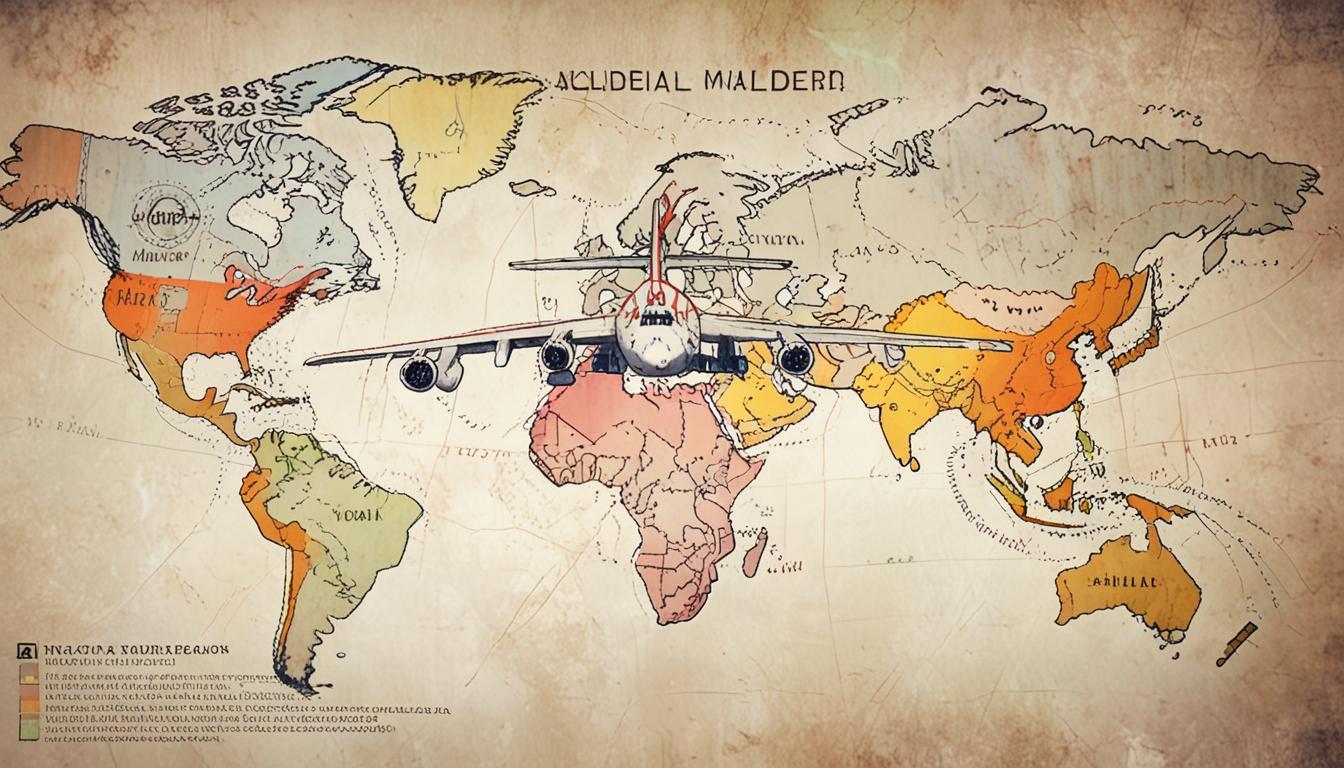The aviation industry is revising Cold War-era policies and insurance frameworks to allow continued flight operations following a nuclear incident, reflecting concerns over modern tactical nuclear weapons and ongoing geopolitical tensions.
Airlines are exploring new protocols to ensure operational continuity in the event of a nuclear conflict, aiming to prevent disruption for passengers eagerly anticipating their travels. Traditionally, in the aftermath of a nuclear detonation, a blanket policy mandated the grounding of all civil aircraft globally—a response rooted in Cold War-era assumptions about total warfare. However, industry leaders are now questioning this approach, particularly as the nature of nuclear weapons evolves.
The current policies, which date back to the 1950s, are seen as increasingly obsolete, especially with the emergence of tactical nuclear weapons capable of limited battlefield use. Senior partner at Gallagher, Nigel Weyman, highlighted that these weapons are designed to create localised impacts rather than escalating into global Armageddon scenarios, a sentiment echoed among security specialists. The explosion power of modern tactical warheads can be significantly less than that of historical nuclear bombs; for example, America’s B61 bombs can have yields as low as 0.3 kilotons compared to the 100 kilotons of the Hiroshima bomb.
This shift in understanding has prompted the insurance industry to reassess its policies. Gallagher, one of the world’s largest aviation insurance brokers, has begun a thorough examination of coverage options that would facilitate continued operations even after a nuclear incident. Under proposed plans, a coalition of insurers would initiate assessments within four hours of a nuclear event to determine safe airspace for airlines, potentially allowing flights to continue in unaffected areas. Currently, around 100 airlines have engaged with this initiative, which seeks to provide substantial war coverage of up to $1 billion per aircraft for passengers and third parties.
The strategic realignment comes amid rising geopolitical tensions, notably the conflict between India and Pakistan over Kashmir and the ongoing war in Ukraine. The latter has particularly heightened concerns regarding aviation safety and insurance premiums in Eastern Europe, forcing the industry to reconsider existing frameworks that dictate operational responses in crisis situations. As the International Air Transport Association (IATA) has stressed, there is a pressing need for a comprehensive review of war risk insurance policies to better align with modern threats.
Weyman argues that the inherent risks associated with air travel necessitate a pragmatic approach. He questioned the rationale behind grounding aircraft in the event of a minor nuclear incident, suggesting it was disproportionate to the actual threat posed. Such views reflect broader industry sentiments that prioritise maintaining air connectivity while ensuring passenger safety.
The response from the aviation sector has not gone unnoticed. Airlines are actively working to adopt adaptive strategies—rerouting flights, enhancing security protocols, and collaborating with international regulatory bodies—to navigate the complexities introduced by contemporary geopolitical challenges. This approach is indicative of a broader trend where the aviation industry must remain resilient in the face of evolving risks.
However, potential stumbling blocks remain. Current insurance policies contain clauses, such as the ‘five-powers war clause’, which could invalidate coverage in the event of military escalation involving major world powers. This aspect underscores the delicate balance insurers must strike between providing adequate coverage and mitigating exposure to catastrophic risk.
As the global landscape continues to shift, the imperative for a proactive and nuanced approach to aviation insurance and operational policy adaption has never been clearer. The initiative by industry leaders to revise outdated frameworks reflects an understanding of the modern battlefield and a commitment to safeguarding international air travel.
Reference Map
- Paragraph 1: Source 1, Source 2
- Paragraph 2: Source 1, Source 2
- Paragraph 3: Source 2, Source 5
- Paragraph 4: Source 4, Source 5
- Paragraph 5: Source 7
- Paragraph 6: Source 3, Source 5
- Paragraph 7: Source 6
- Paragraph 8: Source 1, Source 2, Source 4
Source: Noah Wire Services
- https://www.dailymail.co.uk/news/article-14701451/nuclear-war-stop-flights-experts-change-policies.html?ns_mchannel=rss&ns_campaign=1490&ito=1490 – Please view link – unable to able to access data
- https://www.dailymail.co.uk/news/article-14701451/nuclear-war-stop-flights-experts-change-policies.html?ns_mchannel=rss&ns_campaign=1490&ito=1490 – This article discusses how airlines are reevaluating policies from the 1950s that mandate grounding all civil aircraft worldwide after a single nuclear detonation. Experts, including Gallagher’s senior partner Nigel Weyman, argue that such policies are outdated, especially with the advent of tactical nuclear weapons with lower yields. The insurance industry is exploring plans to allow flights in regions unaffected by conflict, with a group of insurers ready to assess flight safety within hours of a detonation. Approximately 100 airlines have signed up for this plan, which offers $1 billion per plane in war cover for passengers and third parties.
- https://en.wikipedia.org/wiki/War_risk_insurance – War risk insurance is a specialized coverage that protects against damages resulting from acts of war, including invasion, insurrection, rebellion, and hijacking. Some policies also cover damages from weapons of mass destruction. This type of insurance is prevalent in the shipping and aviation industries and differs from standard insurance by not including a broad war exclusion clause. It typically comprises two components: war risk liability, covering individuals and items inside the craft, and war risk hull, covering the craft itself. Premiums are influenced by the political stability of the regions the vessel or aircraft operates in.
- https://www.iata.org/en/pressroom/2022/2022-06-15-01/ – The International Air Transport Association (IATA) has called for a comprehensive review of war risk insurance policies to ensure they remain relevant in the context of modern geopolitical tensions. IATA emphasizes the need for policies that accurately reflect current risks, including the potential use of tactical nuclear weapons, and advocates for a collaborative approach between airlines, insurers, and governments to develop effective solutions that maintain global air connectivity while addressing emerging threats.
- https://www.reuters.com/article/us-ukraine-crisis-insurance-idUSKBN2A10Z0 – In response to the escalating conflict in Ukraine, the aviation insurance industry is reassessing its coverage policies. Insurers are considering adjustments to war risk premiums and coverage terms to account for the increased risk in Eastern Europe. The article highlights the challenges insurers face in balancing the need to provide coverage for airlines while managing exposure to heightened geopolitical risks, including the potential use of tactical nuclear weapons in regional conflicts.
- https://www.bbc.com/news/world-60525350 – The BBC reports on the global implications of the Ukraine conflict, including its impact on international air travel. Airlines are facing increased insurance premiums and potential route adjustments due to the heightened risk environment. The article discusses how the conflict has led to a reevaluation of existing policies, with a focus on ensuring passenger safety while maintaining operational viability in affected regions.
- https://www.airlines.org/news/airlines-respond-to-ukraine-crisis-with-safety-measures/ – The Airlines for America (A4A) association outlines the measures airlines are implementing in response to the Ukraine crisis. These include rerouting flights to avoid conflict zones, enhancing security protocols, and collaborating with international aviation bodies to ensure compliance with updated safety standards. The article emphasizes the industry’s commitment to passenger safety and the importance of adaptive strategies in the face of evolving geopolitical challenges.
Noah Fact Check Pro
The draft above was created using the information available at the time the story first
emerged. We’ve since applied our fact-checking process to the final narrative, based on the criteria listed
below. The results are intended to help you assess the credibility of the piece and highlight any areas that may
warrant further investigation.
Freshness check
Score:
8
Notes:
The content references ongoing geopolitical tensions, such as the Ukraine conflict, which are contemporary concerns. However, specific updates on airline protocols for nuclear conflicts may be considered less recent given the lack of explicit dates.
Quotes check
Score:
6
Notes:
There are no direct quotes provided in the narrative with sufficient context to verify their origin online. References to Nigel Weyman’s sentiments do not offer a clear first mention.
Source reliability
Score:
7
Notes:
The narrative originates from the Daily Mail, a well-known but sometimes controversial publication. While it has a large readership, it may not be considered as reliable as more neutral or specialized sources like the BBC or Reuters.
Plausability check
Score:
8
Notes:
The claims about airlines and insurers reassessing policies due to evolving nuclear threats seem plausible, given rising geopolitical tensions and the observed shift in warfare strategies.
Overall assessment
Verdict (FAIL, OPEN, PASS): OPEN
Confidence (LOW, MEDIUM, HIGH): MEDIUM
Summary:
The narrative is plausible and addresses contemporary geopolitical challenges, but lacks specific dates and relies on a source with mixed reliability. Further verification is needed for absolute accuracy.













